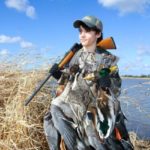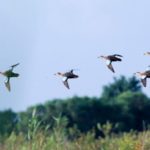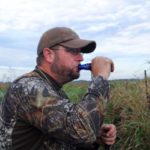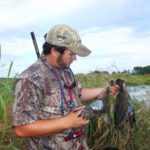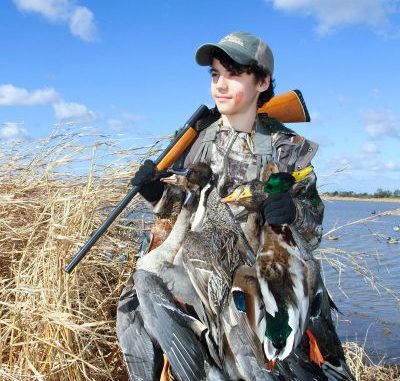
If you’re looking for the perfect place to be this month for the special teal season, it doesn’t get any better than the ag fields of Southwest Louisiana. Here’s why, and how you can ensure you have a bang-up teal hunting season.
My plan was well thought out for the opening day of teal season, but apparently the birds didn’t get the memo, e-mail, text — aw, heck, whatever method birds use to communicate one to another.
But it really was a good plan.
According to 2014 United States Fish and Wildlife Service Trends in Waterfowl Population Survey there were some 8.5 million breeding pairs of blue-winged teal during the spring survey.
Add their offspring over the summer, and we had the makings of something special migrating south come fall.
The plan was to set up on our family’s lease near Burns Point above the Atchafalaya Delta Wildlife Management Area, which might be two miles as the crow flies, give or take.
Opening day the Wax Lake side of the WMA would be crowded with hunters, so with all of the shooting I’d get the overflow — no doubt.
Well, unlike the reports coming from the southwest rice fields, I scratched just three blue-winged teal. Not much considering all of the preparation going into the shoot.
Moreover, with all the hoopla leading up to the special season, it was a disappointment.
I know true sportsmen aren’t supposed to feel that way, but it was my own fault. I got caught up in the numbers and early prognosticating.
Week two of the season wasn’t much better on a hunt I made with a friend near Forked Island below Abbeville. That didn’t seem to stop the Facebook, Twitter and Instagram posts.
They just kept on coming from the rice fields.
I was desperate to have one good teal hunt before the whole shebang was over, so I made a phone call to Brent Sawyer, owner of Heritage Hunting Services in Welch.
I had met Sawyer during the spring at a waterfowl-calling workshop he had organized, and I stayed in touch with him through social media.
He and his partner Robbie Hutchins were having some pretty good shoots during the special teal season, in spite of a migration that seemed to stall at times according to some rice farmers.
Nonetheless, Sawyer, a friend of his Steven Poole and I would hunt the next-to-last day of the season.
What’s unique about Heritage Hunting Services is not only that they are located in the prime Southwest Louisiana agricultural flyway, but that they also are true to their name.
During the combined 2014-2015 special teal and regular big-duck seasons, 17 youth hunters killed their first ducks.
“We’re not exclusive to anyone who wants to come hunt,” Sawyer said. “We have a passion for getting families, kids and those that don’t typically have an easy opportunity to get out in the field. We wanted an operation where men or women … where they would not feel embarrassed or awkward having to take it slow and easy to get out there.
“But, also seeing kids get their first bird is one of the most-exciting measures of our success.”
The Welch area Sawyer hunts north of I-10 is the sweet spot when it comes to waterfowl hunting.
Due south is Lacassine National Wildlife Refuge, which is key to the region’s wealth when it comes sheer numbers.
And the surrounding agriculture fields used for rice and crawfish farming provide a tremendous food source for migrating waterfowl — particularly teal.
Teal are small puddle ducks that prefer shallow water in which to feed. So flooded rice fields and crawfish ponds are the perfect depth for this species.
It also doesn’t hurt to know what you’re doing when it comes to managing for waterfowl.
Sawyer and Hutchins have backgrounds in forestry. In fact, land management consulting — with a focus on wildlife — is how Sawyer makes his primary income.
Ditch line and pond control; timber management; supplemental vegetation; food plots; and hard surveys for deer, turkey, small game and waterfowl all fall under his umbrella of services.
But, the knowledge he possesses is key to how he manages his fields for teal.
“Most of the time when you lease from a farmer, especially in Southwest Louisiana, the farmer tells you what you’re going to get and when you’re going to get it,” Sawyer said. “Farming is the No. 1 priority, and hunting is the secondary source of income.
“The farm we hunt is not an agricultural property. It was at one time. So we’re able to plant some rice and millet, some natural grasses and vegetation, and flood them up on a schedule. It really makes for a waterfowl paradise, especially for teal.”
Poole, Sawyer and I jumped on his four-wheeler and headed to his field. We hunt out of a blind he prepared along a levee between two ponds.
Hutchins would be hunting an agricultural field about a quarter mile away on the property with a group of clients.
There was no expectation of a bang-up shoot on the next-to-last day of the season.
But I’d take whatever nature provided and be happy.
The birds were there, all right, but didn’t work very well at first. They were obviously skittish from getting shot at from every open body of water they tried to land in for morning breakfast.
Hutchins’ guys were the first to fire after legal shooting light.
And after hearing the crew fire a couple more volleys, we were beginning to have some reservations to our shoot.
But our time came a short time later, when a group of teal slipped in low behind us.
You could hear the swoosh of their wings cutting the air as they made their typical bunched-up flight formation arc around us.
We fired and splashed a couple.
The pressure was off.
“The birds were slow to migrate this past year, and those that did make it down were clumped and bodied up,” Sawyer said. “But because we were able to control our water for hunting rather than for farming, we had water well in advance of the early teal season.
“We were holding the teal before opening weekend, and we had food, vegetation and cover for them when they got here — key things if you’re going to run a successful hunting operation.”
A lot of hunting outfits treat teal season as a primer for the big duck season, so they don’t take the extra time hiding like they normally would.
Moreover, teal are early morning fliers, so hunters don’t always have to cover up — at least during the first salvos of the season.
“Opening morning you can just about stand out on a levee in an orange T-shirt and kill teal,” Sawyer said. “Come Monday, you can’t do that. The second Saturday, there’s no way you can do that.
“Many guys forget that you still need to hide. You still need to be concealed. You can get away with a lot during teal season, because it’s not like shooting speckle bellies in January. But, concealment is going to help you have a consistent teal season.”
Sawyer said that, to be consistent, hunters should watch their backdrops.
“I hunt so many different species of game animals,” Sawyer said. “Your backdrop is important so you’re not silhouetting yourself. Deer, turkey and waterfowl can all see that.
“In the particular locations we hunt in Welch, especially along the levee between ponds. I want camouflage in front of me, behind me and on both sides of me.”
One thing I noticed immediately when looking out in the pond at the spread Sawyer had set up for us was that there were several big decoys. Upon close examination they were mottled duck dekes.
“When hunting teal, I like to take the extra steps to make my spreads as realistic as possible,” said Sawyer, who also owns Odyssey Outdoors and sells a full line of full body Blue Collar Decoys. “The farm we hunt in Welch holds lots of mottled ducks throughout the year. So, it makes sense to me to put out mottled duck decoys.
“There are times when blue-winged teal will come in with mottled ducks, and if the mottled ducks flare, so do the teal. By having a realistic spread with mottled ducks in it, we give them something to see from a distance.”
Spinning-winged dekes also can close the deal on teal.
“One thing I really believe in is to make sure motion decoys are in the spread,” Poole said. “Rotating-wing decoys like Mojo provide something teal can see far off, where they’ll be enticed to come to your setup.”
When it comes to calling blue-winged teal, many hunters use mallard calls and even pintail whistles just as they would for big ducks to get their attention.
Sawyer, however, uses a teal call during this early season.
“I think that using a teal call can sometimes make a difference between having the birds work and come toward you or not,” he explained. “With teal hunting, calling isn’t as important as it is with mallards or pintails, but it is effective — especially when done properly.
“Haydel makes a fantastic teal call. Riceland Custom Call’s owner Bill Daniels makes some incredible teal calls. They sound good, and the high-pitch squeal sounds like a teal but also carry that undertone that many other teal calls lack.”
Having a lease of my own, over the years the one thing I tried to emphasize with members when it comes to duck hunting is never to shoot the same pond two days in a row.
The early teal season is no different. All waterfowl are pressure sensitive, a fact proven on several of the coastal wildlife management areas.
Quite often, WMA hunters will have great opening weekend shoots and watch things drop off by the second weekend.
By contrast, weekday WMA hunters often talk of stellar hunts, when the crowds have dispersed from the weekend shoot.
Moving around and giving the birds a rest is important on Hunting Heritage Service’s property, too.
“We try not to hunt the same hole everyday. We do not hunt the evenings, either,” Sawyer said. “Plus, during teal season we get out of the blinds early.
“We try to give the birds some time to rest and get settled in. Anymore than that, and you run the risk of running the birds off of your location. It’s not worth it to us, ruining our success rate on the farms we hunt.”
A couple of hours into our hunt, we still hadn’t shot our three six-bird each limits. But we had some shooting and were halfway, with a total of nine teal.
By contrast, Hutchins and his group of hunters was doing much better. From our levee location, we could see several large flights of blue-winged teal drop over their blind.
There were no worries; we were having some good conversation on a cool morning, watching some great dog work by one of Poole’s Labrador retrievers he trains and just enjoying one of the final days of the early September teal season.
Was I satisfied? Heck yea!
For a next-to-last day teal hunt we did well.
But, one thing I made a mental note of: Come the 2015 early teal season, I’m going west, young man, to Welch.
Editor’s note: Heritage Hunting Services can be reached at 318-306-1532 or 318-308-2995, or look them up on Facebook.
